How to Train For the Trails

You train hard, you train regularly, but how often do you actually work out for a full day while carrying a 20-pound weight up and down an incline? This is precisely what you’re doing when you hit the trails to go hiking, and many people don’t consider the strength and stamina needed to spend a full day balancing the weight of a backpack while trekking over uneven terrain.
“Folks tell us, ‘I’m in great shape for the gym, but when I go hiking for six hours, the training I do doesn’t really translate,’” says Anne Peick, senior field instructor and staffing coordinator for the National Outdoor Leadership School in Lander, Wyoming. But that very challenge, plus majestic views and the soul-soothing elixir of the great outdoors, is exactly what draws gym rats away from the treadmill and into the wilderness.
Regardless of your proximity to the nearest wooded path, you can tailor your training so that when you do hit the trail, you’re putting your best boot forward. Pete McCall, adjunct faculty in exercise science at Mesa College in San Diego, says that even regular gym-goers should plan ahead. “If it’s going to be a longer, multi-day hike, I would advise taking six to eight weeks to prepare,” McCall says. “If it’s going to be a one- or two-day hike on a different terrain than you’re used to, then four to six weeks should be enough.” Resistance-training moves should target the core, glutes, quads and hamstrings, and they also should include a variety of single-legged movements because hiking is essentially a series of weighted, single-legged balances. “You want to be able to plant your foot and be confident that you’re going to be stable on one leg,” McCall says.
He also recommends spending more time on your feet throughout the day — not just during training: Most of us exercise in neatly scheduled blocks of 30 or 60 minutes, but even a leisurely hike requires you to be upright for five times as long. Take phone calls standing up, schedule walking meetings and run errands by foot whenever you can.
Also, don’t skimp on cardio, especially if you train at sea level and are headed for high-altitude terrain where the air has a lower concentration of oxygen. Cardiorespiratory exercise (the kind that quickens your breathing and your heart rate) improves maximum oxygen uptake (VO2 max) — the body’s ability to transport and use oxygen.
Not the outdoorsy type? This workout can still be of benefit: The cardio component includes bursts of high-intensity work interspersed with rest, burning calories both during and after the workout; the resistance circuit trains your balance, which is crucial for stability and injury prevention; and the program on the whole focuses on developing the glutes, quads and hamstrings, three key aspects of toned, sexy legs. And even if you’re not planning to carry a day’s worth of provisions on your back, chances are you’re interested in developing a solid core and firm abs.
Adventure (or maybe just a tight butt) awaits. Race you to the top!
Take-a-Hike Circuit
These single-legged movements will train balance, coordination and stability — all of which are imperative for hitting the trails. Working in this order, complete three sets of each movement before transitioning to the next.
| Exercise | Sets | Reps/Distance |
| Hollow Rock | 3 | 12 |
| Bottoms-Up Kettlebell Carry | 3 | 200 meters |
| Single-Arm Overhead Dumbbell Squat | 3 | 8 (each side) |
| Sandbag Crossover Lateral Step-Up | 3 | 8 (each side) |
| Medicine-Ball Overhead Walking Lunge | 3 | 200 meters |
| Barbell Good Morning | 3 | 15 |
| Reverse Lunge to Single-Legged Balance | 3 | 15 (each leg) |
| Banded Single-Legged Romanian Deadlift | 3 | 15 (each leg) |
The 30-Minute Staircase Workout
This high-intensity stair workout will get you to the summit and torch tons of calories in the process. Any set of stairs — like the steps to your basement or the bleachers at a local track — will work. Are you able to crush three rounds in less than 30 minutes? Add another round, or tack on a fourth trip up and down the stairs to each set and really push your limits.
| Time/Rounds | Activity |
| 1 Minute | Do mountain climbers at the base of the stairs. |
| 3 Rounds | Jog up/walk down the stairs at a brisk, sustainable pace. On the descent, go slowly and focus on placing your foot in the center of each step. |
| 1 Minute | Do alternating lateral lunges at the base of the stairs. |
| 2 Rounds | Walk/jog the stairs two at a time, then walk down. If the stairs are shallow, take three at a time. |
| 30 Seconds | Do jumo squats at the base of the stairs. |
| 3 Rounds | Sprint up/walk down the stairs, driving your knees up and toward your chest with each stride. |
Your Week at a Glance
To get yourself into expedition shape, incorporate the 30-Minute Staircase Workout and Take-a-Hike Circuit into your current training plan three times a week. You can split them up or perform them back-to-back, so long as you start with the resistance training. Here’s what a sample week might look like.
- Monday: Take-a-Hike Circuit + 30-Minute Staircase Workout
- Tuesday: 60-Minute Spin or HIIT Class
- Wednesday: Take-a-Hike Circuit + 30-Minute Staircase Workout
- Thursday: Rest
- Friday: 30-Minute Staircase Workout
- Saturday: Take-a-Hike Circuit + 30-Minutes of Yoga or Stretching and Mobility Work
- Sunday: Rest
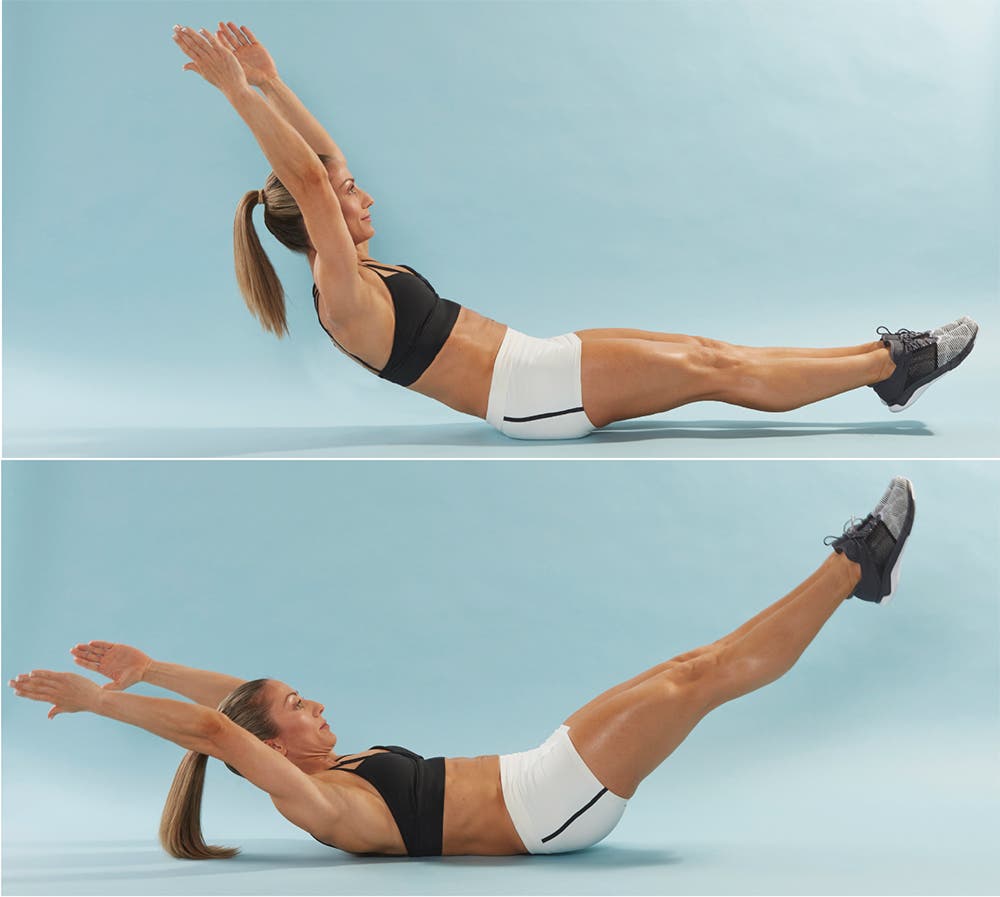
Hollow Rock
This movement fires up your midsection, priming your core for hiking with a loaded backpack.
Lie faceup with your legs together and stretch your arms overhead. Press your lower back into the floor, tighten your glutes and then lift your head, shoulders and legs off the floor, creating a shallow U-shape with your body. Maintain this position as you rock back and forth from shoulders to heels, breathing throughout, for reps.
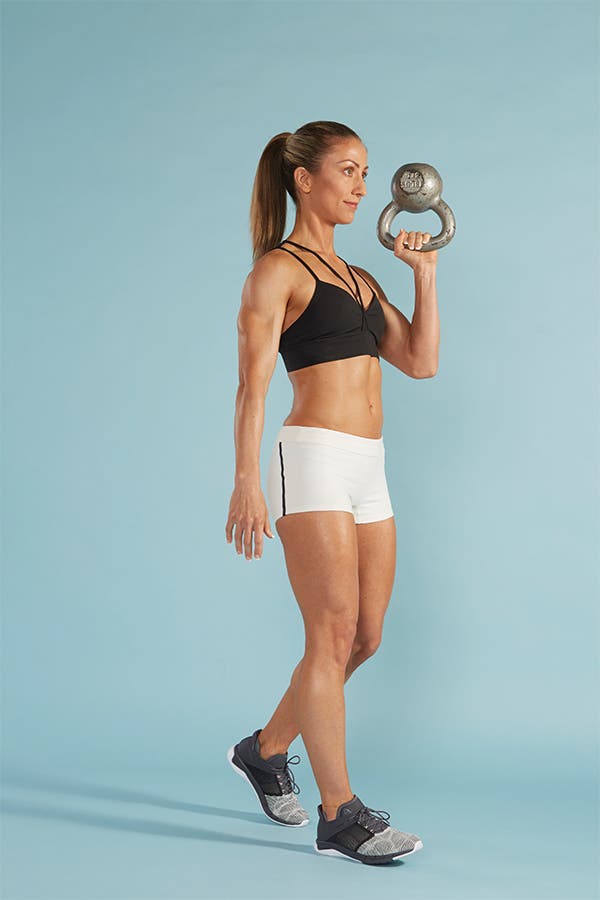
Bottoms-Up Kettlebell Carry
This version adds a level of instability, making your core work double time to keep the weight steady.
Hold a kettlebell by the handle with the bottom pointing upward and lift it to shoulder height, wrist straight, elbow down and close to your body. Walk forward slowly for 100 meters, taking small steps and keeping the weight as steady as possible. Switch hands and walk back to the start to complete one round.
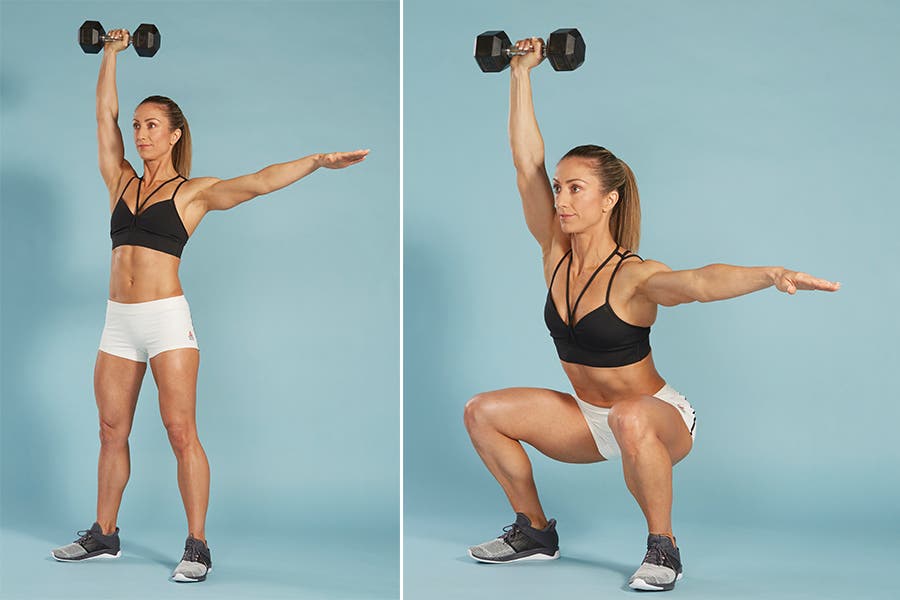
Single-Arm Overhead Dumbbell Squat
This move challenges your quads, core, shoulders and hip stabilizers.
Stand with your feet wider than hip-width apart, legs turned out slightly, and hold a moderately heavy dumbbell directly overhead, wrist aligned with your shoulder. Extend your other arm to the side and square your hips. Actively press the weight upward as you kick your hips back, bend your knees and lower into a deep squat, back flat and chest lifted. Drive through your heels to return smoothly to standing. Do all reps on one side, then switch.

Sandbag Crossover Lateral Step-Up
This move engages the gluteus medius and minimus, stabilizing your pelvis while developing agility and lateral stability.
Hold a moderately heavy sandbag over your right shoulder and stand to the left of a knee-high (or lower) plyometric box. Using your right foot, step across your body and onto the box, planting it in the center. Extend your right leg and hip and stand up on top, allowing your left foot to hover above or lightly rest on top of the box. Step back off — left foot first, then right foot — to return to the start. Do all reps on one side, then switch.
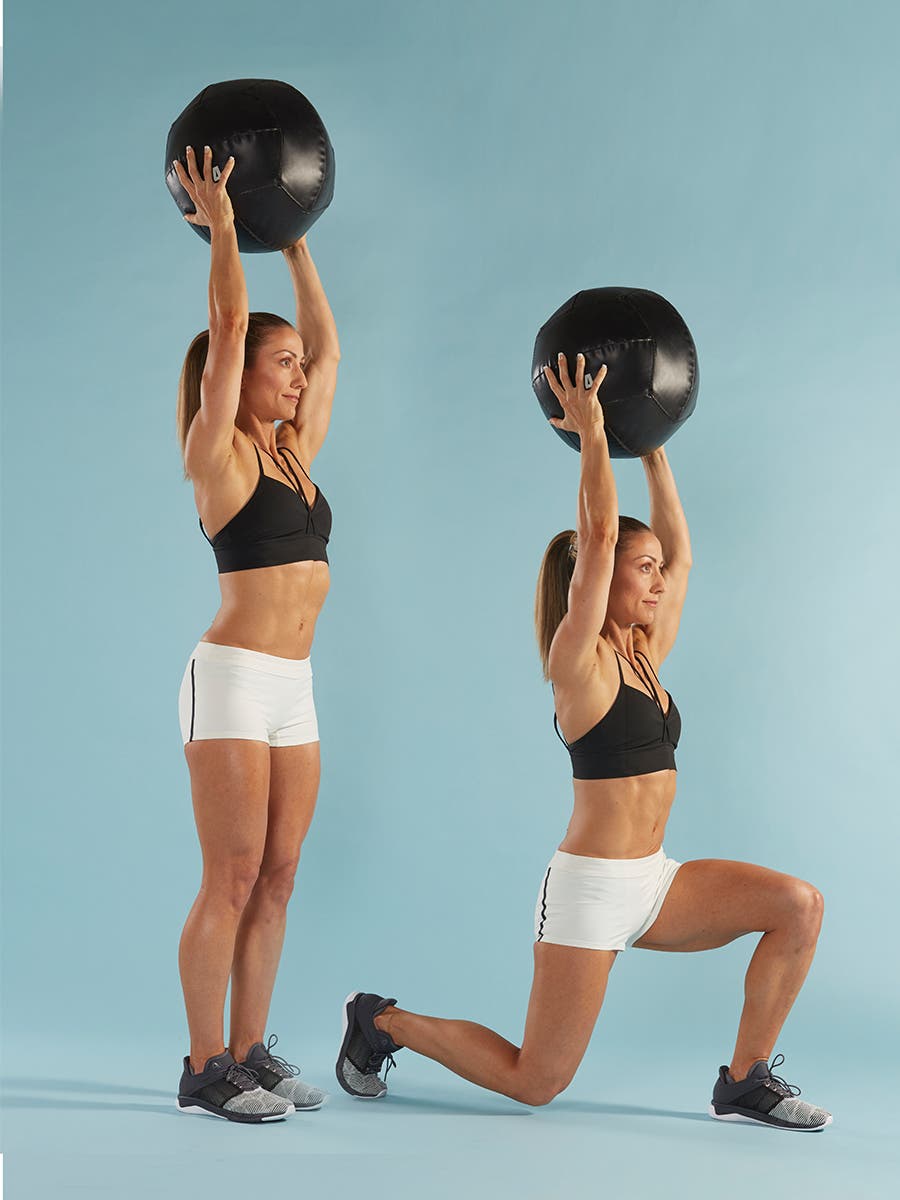
Medicine-Ball Overhead Walking Lunge
This move works your total body with this added bonus: The overhead position of the weight keeps your posture in check, forces you to engage your core and adds extra resistance.
Stand with your feet hip-width apart and hold a medicine ball directly overhead with both hands. Your arms should be straight, back and head neutral, abs tight. Take a large step forward with one foot and bend both knees to lower into a deep lunge. Push off your back foot and bring your legs together, stepping forward. Continue, alternating legs, for distance.
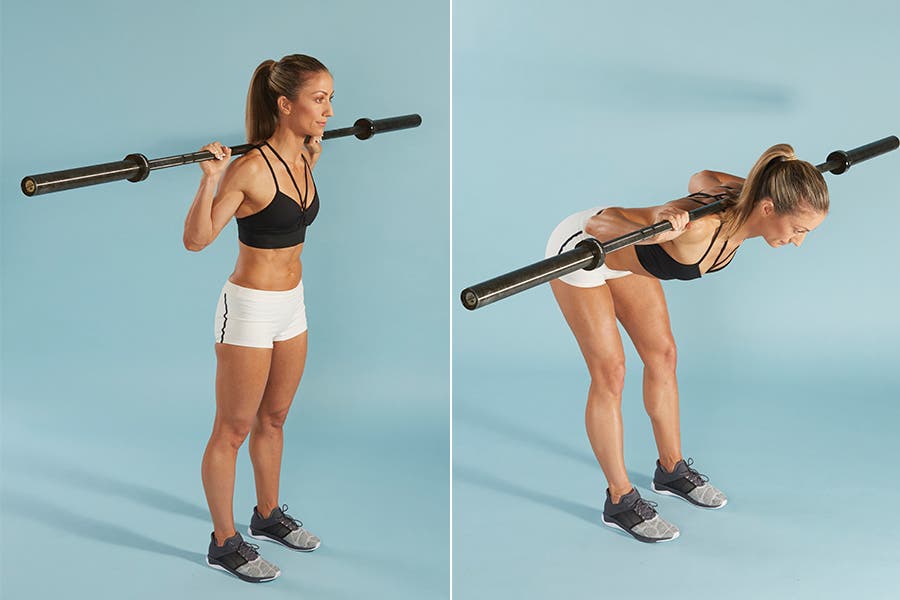
Barbell Good Morning
Want to slay hilly terrain? This is your new go-to glute and ham move.
Hold a barbell across your upper back and traps and stand with your feet hip-width apart, knees slightly bent. Keeping your back flat and your neck neutral, hinge at the hips and push your glutes rearward, folding forward until you feel tension in the hamstrings. Pause briefly, then drive your hips forward to return to standing.
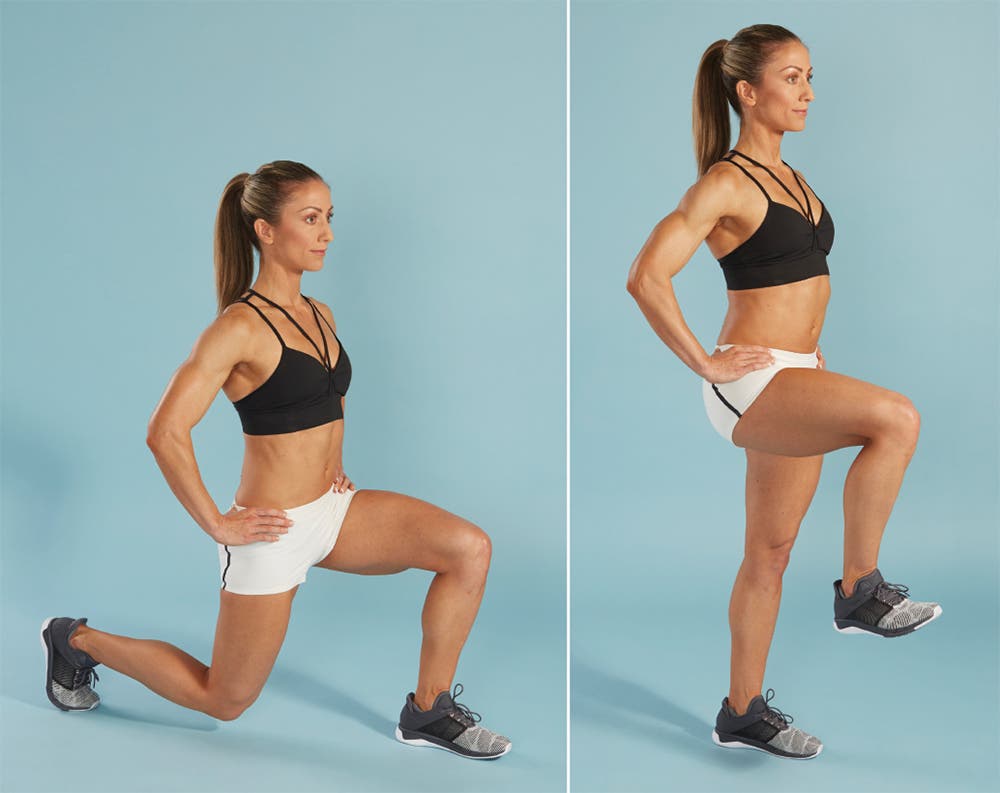
Reverse Lunge to Single-Legged Balance
Simple but effective, this move activates the quads as well as the smaller, stabilizing muscles of your hips, knees and ankles.
Stand with your feet hip-width apart, hands on your hips. Step your right foot back and bend both knees deeply in a reverse lunge. Drive through your left foot to stand up and pull your right leg forward and upward, raising your knee to hip height or slightly higher. Balance here for a count of two, then repeat. Complete all reps on one side, then switch.
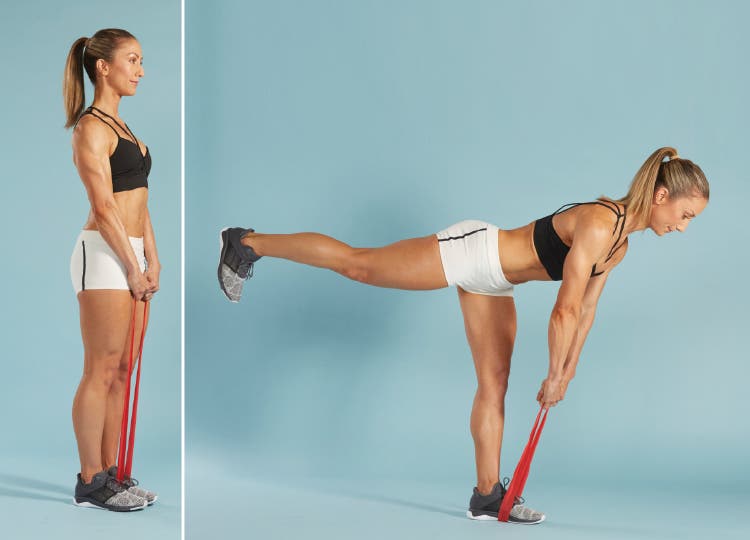
Banded Single-Legged Romanian Deadlift
This variation smokes your posterior chain while honing your balance.
Place one end of a light resistance band under your left foot and hold the other end with both hands, choking up on it to increase resistance. Balance on your left leg as you simultaneously lift your right leg and lower your chest toward the floor, back and leg straight, hips square. When your torso/leg are roughly parallel to the floor, drive your hips forward to return to standing. Do all reps on one side, then switch.